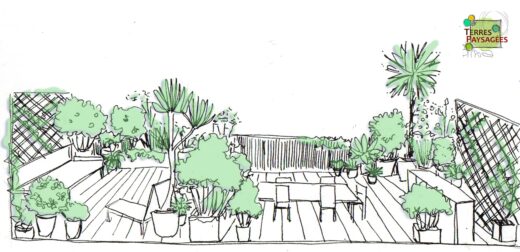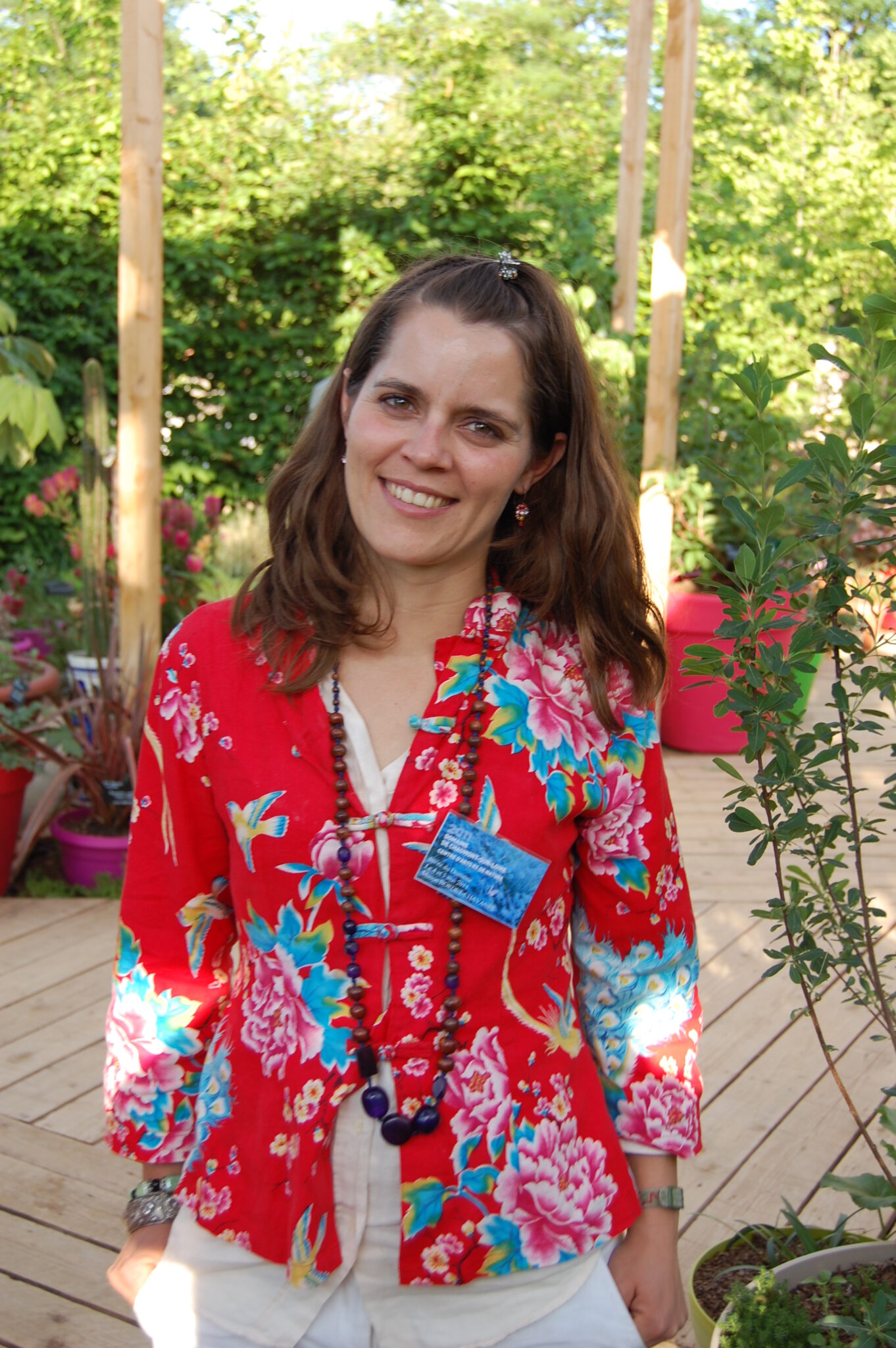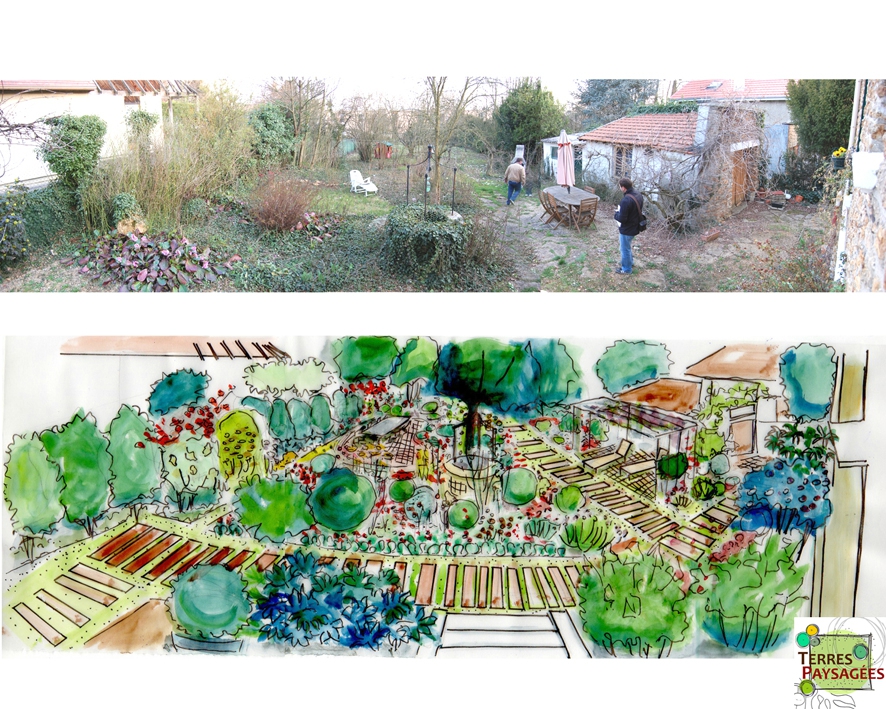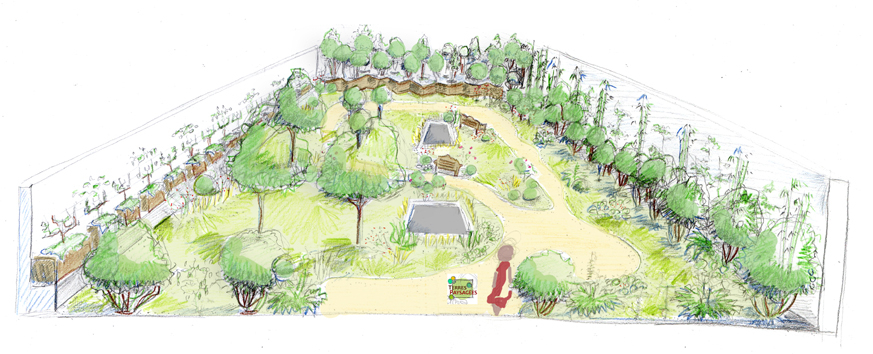
Here’s the second part of our exchange with Manon (see first part).
 >Manon, can you tell us what concepts are important to you when creating a landscape design?
>Manon, can you tell us what concepts are important to you when creating a landscape design?
Planting local species as a priority, adapting to the environment from which you can draw inspiration, is often a guarantee of successful, long-lasting planting (less need for watering, or even none at all!);
Buy from local nurseries: the plants have grown in conditions closer to the gardens to be landscaped and will be better adapted to the climate;
Minimize watering by :
with native species and a plant palette adapted to the region and environment,
conserving soil moisture with mulches (no plastic sheeting, only biodegradable or mineral mulches: provided you don’t see any “weeds”, you’ll be looking at unsightly sheeting for years to come, and it won’t be environmentally friendly at all). These mulches reduce weeding by preventing weeds from establishing and competing with young plants.
Staggered planting to make the most of the space in the beds: tree/shrub/ground cover.
Grass=maintenance; use other plantings (ground cover, perennials…) if possible. Failing that, adopt a reasoned management approach: lawns and ornamental plantations in the immediate vicinity of the house with careful maintenance, and reduce maintenance with distance to create a more natural appearance at the bottom of the garden (mowings spaced out over time, flower meadows with grassed paths that move with the mowings…).
To highlight this plant diversity, a certain repetition of neutral, structuring species (boxwood, pittosporum tobira, ilex crenata, salix rosmarinifolia…), pruned or slow-growing, and a coherence of materials seem essential to me to avoid creating a “catalog” or making the garden unreadable.
>what advice would you give to people who are going to create their outdoor spaces with My Garden Designer garden software, to ensure a harmonious creation?
Choice of plants
First, observe the existing vegetation, what works and what doesn’t, and even what’s nearby, and build on that.
Do not multiply materials, but extend existing ones or use those of the building (wood, stone, brick, slate, etc.) and repeat them in furniture (paving, seats, etc.).
Designing the garden for the most difficult season, winter. If the garden is beautiful in winter, it will be in the “easier” seasons.
Remember to stagger flowering throughout the year, and even fruiting afterwards. Ideally, you should have at least one interesting plant (color, bloom, fragrance, etc.) per season.
Flowers are certainly important, but they are often present for only one season of the year, while foliage, fruit and bark are to be taken into account for almost 3 other seasons! The shades of green are almost infinite, the graphic effect of foliage and the lightness of grasses add interest to the garden in any season.
Don’t start with too many different varieties. Plant each species, repeating it throughout the garden to create unity, ideally in odd-numbered occurrences (3 is good enough for a small garden).
Planting plants with a common thread of color – flowering, bark, foliage, fruit… -is a good way to achieve harmony. Neutral tree species – with discreet blossoms and green foliage – provide the visual breathing space to showcase them to best advantage.
If you’re on a tight budget (as is often the case), consider low-maintenance perennials (don’t hesitate to leave wilted inflorescences in winter, as frost will work wonders with them!) Also think about bulbs, excellent value for money, interesting in spring.
Choose plants for all uses, culinary, home pharmacopoeia, scented, flowering, for bouquets, for wildlife and pollinators…(thymes, rosemary, laurel, chamomile, fennel, lavender, sage, santolin, phlox, lime, wintergreen, citrus, fruit trees, decorative and fruit climbers… )

Garden structure
Plant higher up at the bottom of the garden, lower down in the foreground of the bed, reducing the size by a third at each notch, to give an impression of perspective and enlarge the space.
Multiplying “tiers” – trees, large shrubs, medium-sized shrubs, small shrubs, ground cover – minimizes maintenance (mowing, weeding) and watering by providing good ground cover and optimal space occupation.
Place key elements (pot, majestic shrub, decorative element) in the axis of perspectives, visible from windows to serve as a visual focal point.
Think of herbs near the kitchen, and scented shrubs/greens around openings and living areas to enjoy them.
Plants I particularly like
Shrubs: Pittosporum tobira for its graphic, evergreen foliage and fragrant blooms; arbutus, with its flowers, edible fruit and decorative bark in the autumn, Cornus Bâton Rouge for its incredibly red twigs in winter, hamamelis for its atypical flowering, Cercidiphyllum japonicum, Arbre au caramel for its sweet smell and autumn foliage, Acca sellowiana for its edible fruit, flowers and silver evergreen foliage, Ilex crenata to replace boxwood at lower cost, and santolin for its colorful evergreen ball effect.
Perennials: Mackleya cordata for its unique foliage, the coffee lily Schizostylis coccinea for its winter bloom, giant alders for their ball effect, physalis alkekenghi for its orange lanterns (in pots because they can be traced), euphorbias for their tangy green, grasses in all seasons (Molinie, stipa, luzula in particular…), Nepeta, the aromatic long-blooming blue and Calendula officinalis, the long-blooming marigold….), Nepeta, a long-blooming blue aromatic and Calendula officinalis, the long-blooming all-rounder…
and ground cover: Persicaria affinis Darjeeling Red for its pink carpets and Corydalis lutea, long-flowering evergreen, creeping thyme…
Climbers : Akebia quinata for its distinctive, fine blooms, star jasmine for its fragrance and old roses for their romanticism…
thank you Manon and see you soon for more beautiful creations.

